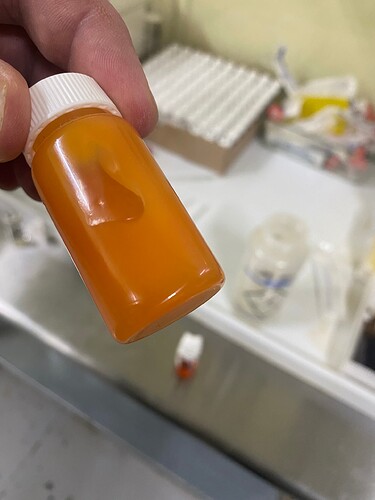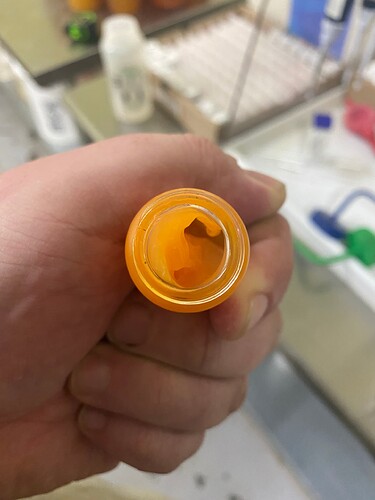So I’ll start from the top, we’ve been processing some hemp co2 oil for a client. The crude was very poorly extracted and as such has a pretty abysmal potency. Most of the material is around 35% TAC post winterization. What we’ve seen after distillation is really puzzling…
20% TAC co2 hemp crude oil Gets distilled, yields about 30% of input and hardly increases in TAC…showing only 25% total cannabinoids after first distillation…The thing that really throws me off is the viscosity… the distillate is like water at room temp… 190c on the boiling flask, 170-180 head/vapor temp, 60c on the condenser arm, 250-500 micron vacuum depth.
The video shows the viscosity of the first pass distillate at room temp. The pictures show the vial after we froze the distillate.
Tried a methanol test, and at room temp the mixture has a perfectly see through opacity, once frozen it resembles the applesauce texture, slurry mixture one sees right before CBD fully crashes out of hexane/pentane. I’ll get pictures of the methanol test after this weekend.
Any ideas, future fam?
1 Like
What did your terp pull yield? Also, do you think at those parameters more cbc is there making it more runny?
Was the starting material full of seeds? I ran some seeded crop one time and that’s what it looked like. But I didn’t have testing at the time to verify.
4 Likes
Could hemp seed oil be distilling over?
1 Like
Sounds like a whole buncha bullshit that codistills with cannabinoids.
If you’ve winterized and distilled and it’s at 35%TAC there just be some unconventional BS in there.
Maybe wash it w some water in an LLE
8 Likes
I ran a ton of stuff that was seeded by hemp slightly and all the distillate came out runny ish after 2nd pass. Had it tested for foreign stuff and it had hemp seed oil in it.
2 Likes
Second that.
Grab a reactor/conical vessel
Dissolve in 5-8 parts methanol.
Add 1 part hep/hexane
Stir for a few hours (not too vigorous)
Retrieve methanol layer, set heptane layer aside (heptane should contain most of your non-polar impurities, and a little bit of cannabinoids you can retrieve later)
Next, add 4:1 heptane to oleoresin in methanol solution. Stir vigorously. Add 2 parts water to every part methanol. Keep stirring. Then slowly reduce speed and let layers separate.
Your cannabinoids will have moved entirely to your new heptane layer and all your water soluble impurities are now with the methanol/water Louche.
Evap heptane. Redistill.
Then maybe run a chroma column over silica or alumina with an 85% methanol 15% water solution if it’s insanely gross. I think it should stop most junk in its tracks, or at least get some separation.
If that doesn’t fix it… You’re probably fucked 
8 Likes
Have you tested the product for Azadirachtin? Can’t imagine this is due to anything but some kind of oil based spray used by the grower.
3 Likes
The starting material is a factor . Ya it could be seed oils but if it was a cbd conversion and it wasnt done properly it will be runny with low canabinoid %. Even isolate will end up runny if not converted properly . Ive had a few runs that were clear as water from isolate that were runny from not running the temp hot enough during reflux. What you have looks psuedo nucleated cbd with some d8 and d9 in there . From the pic im gonna say the mother liquor wasnt removed completely. Also seen this with crops that were sprayed with sulfur. If this was from d9 material source you may have heads and terps that need to be distilled out . Sulfur and seeds means your gonna have a bad time mmmmk . break it down and do some bakingsoda and brine washes then redistill.
1 Like
Those pictures remind me of the days of running a couple Apeks machines and when we would winterize and separate our lipid, fats, waxes would resemble that. Maybe they sent you their waste to rework? Low tac, viscosity, appearance…just a thought
3 Likes
it totally looks like what’s left after steam distilling a subcritical terp run… so everything with MW between a terp and a cannabinoid.
2 Likes
Volatile sections were huge. I thought right away it was CBC as well but in house analytics show little to none here.
1 Like
It’s certainly possible though I didn’t see the initial biomass at all. We got a huge lot of CO2 crude that had already been extracted. The Crude itself isnt’ particularly runny either, which is odd. Certainly could be hemp seed oil given the incredibly low TAC
2 Likes
After looking again at your 2nd picture, where you froze the distillate, it looks just like the oil/crude I made from the seeded weed. And, I can’t find an article on it without reading like 10 abstracts, but lecithin is commonly found in seeds. And good ol’ Wikipedia states:
Blockquote
Lecithin (/ˈlɛsɪθɪn, ˈlɛsəθ-/, from the Greek lekithos “[yolk]”) is a generic term to designate any group of yellow-brownish [fatty] substances occurring in animal and plant tissues which are amphiphilic – they attract both water and fatty substances (and so are both hydrophilic and lipophilic, and are used for smoothing food textures, emulsifying, homogenizing liquid mixtures, and repelling sticking materials.
I’d bet a Chinese wiper that there’s seed oil in there.
1 Like
I came here to say the same. My first guess like everyone else has said would be seed oils (palmitic acid, myristic acid, etc) knowing how common they are in CO2 oils especially but neem oil is also worth asking the grower about. Some of those triterpenoids can be real messy to identify.
1 Like


